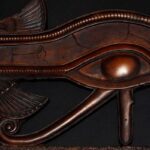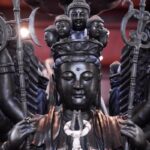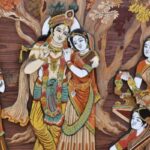We explain who Anubis was in the mythology of Ancient Egypt, what his characteristics were and what symbols represented him.
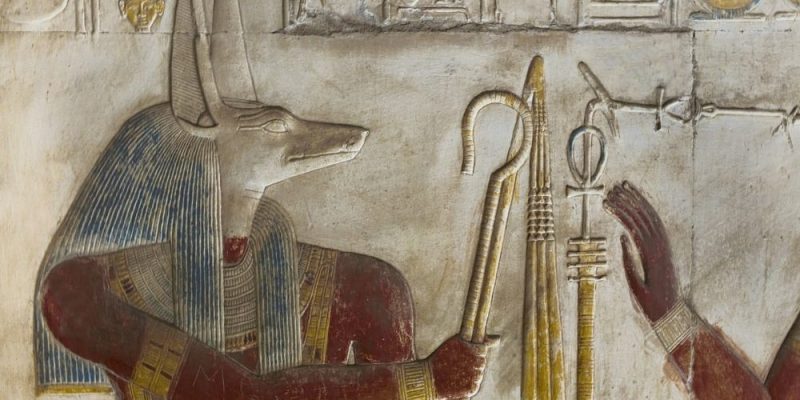
Who is Anubis?
In the religion and mythology of Ancient Egypt, Anubis or Inpu was the name of the god of the dead and lord of the underworld (Duat). He was considered regent of the deceased during the Early Dynastic period and the Old Empire, since in later times he was displaced from that role by Osiris. He was represented as a human figure with the head of a jackal and a cross ankh in the hand.
The best-known epithets of Anubis were “he who resides in his mountain”, “the lord of the sacred country”, “he who is in the embalming chamber” or “he who measures hearts”. It was usually represented on the walls of funerary or mortuary temples, since it was also the patron saint of embalmers and inventor of the mummification technique.
His cult spread throughout Ancient Egypt, especially in the city of Hardaï (also called cynopolis“city of dogs”) for almost three millennia: approximately from 3,200 BC. C. until Christianity replaced the Egyptian religion between the 4th and 6th centuries AD. c.
However, Egyptian texts are unclear regarding the mythological origin of Anubis. In some it is stated that he was the son of Bastet, Idhet or even Ra and Nephthys, or also that he was an illegitimate son of Seth, fathered by Nephthys and raised by Isis to save him from the wrath of his father.
He was generally considered an ancestral deity, and ruler of the world of the dead, until the rise of Osiris to the throne of the underworld. From there, Anubis became a mere embalmer, protector of tombs and guide of the souls of the deceased towards their otherworldly destiny. Theirs was the role of weighing, for example, the hearts of the recently deceased on a scale, to determine whether or not they were worthy of entering the world of the dead.
Anubis also plays an important role in the mythological story of Osiris, central to the Egyptian religion of the time. When Osiris was murdered and dismembered by his brother Seth, Anubis helped Isis and Nephthys rebuild and embalm his body so that he would return to life in the afterlife, where he would be king of the deceased. This myth is the reason why the pharaohs, representatives of Osiris in the human world, were embalmed and mummified.
See also: Gods of Ancient Egypt
Characteristics of Anubis
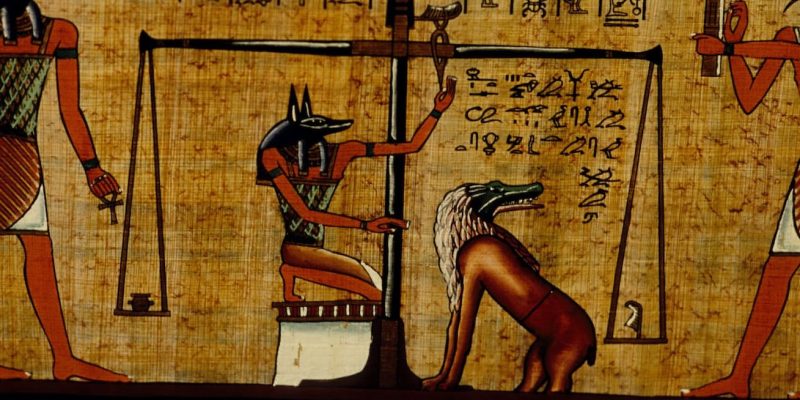
In general, the god Anubis was characterized by the following:
- He was one of the oldest gods of the Egyptian religion and was worshiped throughout the Egyptian Empire for almost three thousand consecutive years.
- It was represented as a human figure with the head of a jackal and in hieroglyphic writing, by means of a canine or wild cat lying on its belly, either on the ground or on a funerary chapel. This is possibly because jackals were the dominant scavenger species in the ancient Egyptian deserts, hence their association with death and corpses.
- It was linked to the color black which for Egyptian religion meant not only death but afterlife: regeneration, eternal preservation and fertility.
- As was often the case with the Egyptian gods, He was related in different cities to Osiris himself and even to Horus especially in its manifestations of Jentyamentiu, Tepyyeduef or Nebtadyeser. Furthermore, his role as guide to recently deceased souls caused the ancient Greeks to assimilate him with Hermes, which gave rise to the name “Hermanubis” at the heart of his cult at Cynopolis.
- Its mythological origin is unclear especially as far as the Osiris story is concerned. It is possible that its birth was invented and reinvented to adapt it to the different religious variants that were developing over the centuries.
Anubis symbols
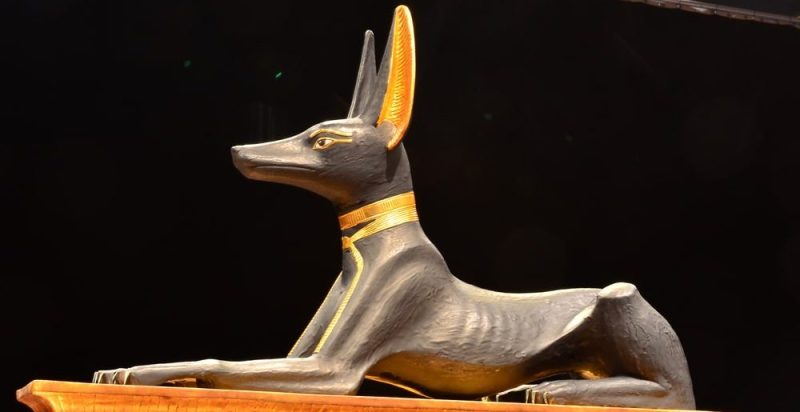
Anubis was a funerary god, and therefore associated with the scavenger animals, such as the jackal, wild dog, and wild cat which is why he is often represented that way, especially next to the mother goddess Isis. That is why the priests in charge of mummification used ritual masks in the shape of a jackal's head.
On the other hand, the color black with which this god was associated not only referred to decomposing corpses, but also to the earth rich in organic matter, so his role was ambiguous and also symbolized fertility, fertilizer and abundance.
On other occasions Anubis was represented holding a scale, since among their roles was to weigh the hearts of the recently deceased, placing an ostrich feather on the other side of the scale, a symbol of cosmic order or Ma'at. If the heart weighed the same or less than the feather, the soul could enter the realm of the dead; If not, he was destined for an end of suffering in the jaws of Ammit, a creature that was part lion and part crocodile.
Egyptian mythology
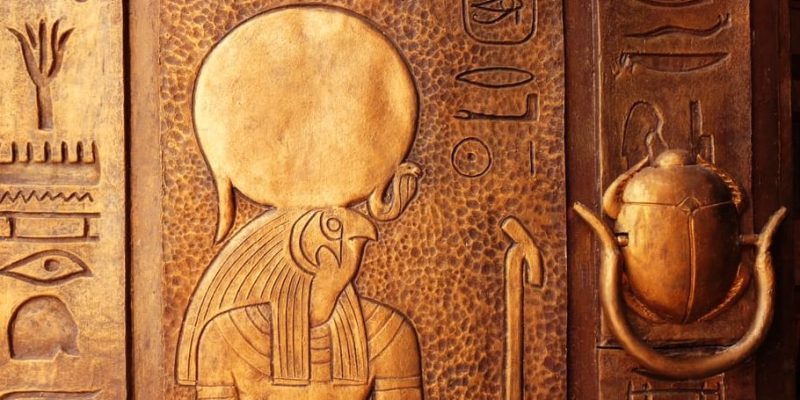
Egyptian mythology covers the set of beliefs, rites, stories and symbols produced in Ancient Egypt (from approximately 3,200 BC to 31 BC) from its predynastic era to the imposition of Christianity around the 5th century. Its iconography and the richness of its stories is comparable to the Greco-Roman tradition, and to a large extent influenced it, through a complex process of syncretisms and hybridizations.
The Egyptian pantheon was ruled by numerous gods, mostly represented as human figures with animal heads and between which there was a complex margin of ambiguity and coincidence, so that the limits of the cult of one god and those of another were not always clear. In this way, two different gods could become one over time, as happened with the gods Ra and Aten, who became Aton-Ra.
The Egyptian gods not only governed nature, but they also governed the order of humans. In fact, The pharaohs were their incarnation on Earth, and for that reason they were destined to rule: to preserve universal balance or ma'atwithout which the world would inevitably end.
Nevertheless, As time went by, Egyptian religion focused on the story of Osiris as the fundamental mythological core: the journey of the solar god, lover of his sister Isis, who is betrayed and murdered by his jealous brother Seth, lord of the deserts.
The story culminates with the goddesses Isis and Nephthys gathering and embalming the body of Osiris according to the practices of Anubis, thus promoting his resurrection as lord of the underworld. It is a fundamentally agricultural myth, which describes the cycles of drought and flood around the Nile thanks to which the fertile soil became usable.
Egyptian gods of death
Death had an important presence in Egyptian mythology, as part of a process of transmigration of souls and preservation of universal balance, the ma'at. For that reason, the world of the deceased (Duat) and the process of death itself were accompanied in its various instances by different gods and deities, such as:
- Anubis. Lord of the necropolis, patron of embalmers and guide of the recently deceased to the underworld, this jackal-headed god was also responsible for weighing the hearts of the deceased to know if they were worthy of entering the kingdom of the dead.
- Osiris. Initially a solar god, inventor of Egyptian agriculture and religion, he was a mythical king who drowned in the Nile, deceived and betrayed by his brother Seth, who then dismembered his body and scattered it throughout Egypt. Then his wife Iris and his sister-in-law Nephthys gathered his body, embalmed and mummified it, and Osiris was reborn in the Dumat as lord of the dead and administrator of the eternal laws of the Ma'at. Only those worthy of entering the realm of Osiris could be reborn later.
- Ammit. Goddess called “devourer of the dead”, she was represented as a monster with the body of a lion and the head of a crocodile, often with the claws of a bird of prey. It played a punishing role in the judgment of the recently deceased, devouring the hearts of those discarded by Anubis, taking away their opportunity to be reborn.
- Thoth. This is an ancient god, associated with wisdom and writing, science, magic and arcane knowledge. The goddess Ma'at, the embodiment of order, is his wife, and the goddess Seshat is her female version, associated with libraries, construction, measurement and astronomy. Thoth played an important role in the measurement of souls carried out by Anubis, since it was he who took note of the weight of the hearts of the deceased and who issued the corresponding verdict.
- Nephthys. Wife of Seth and assistant to Isis in the restoration of the body of Osiris, Nephthys was a goddess associated with both festive aspects of Egyptian religion, as well as funeral rites and embalming. In this last role, she was the protector of one of the canopic vessels: the containers where the organs extracted from the mummies were deposited. This work was carried out by Nephthys (protector of the Hapi vessel, intended for the lungs) together with Isis (protector of the Amset vessel, intended for the liver), Serket (protector of the Qebehsenuef vessel, intended for the intestines) and Neit (protector of the Duamutef vessel, intended to the stomach).
Continue with: Eye of Horus
References
- “Anubis” on Wikipedia.
- “Religion of Ancient Egypt” on Wikipedia.
- “The Mummies of Anubis” in National Geographic.
- “Anubis (Egyptian god)” in The Encyclopaedia Britannica.

